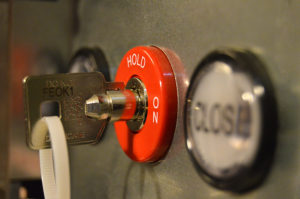Weather Halts Construction – But Not Modular
January 22, 2018Elevator Specs
February 19, 2018Please Use the Fireman Key (Not an Ax)

There is as old joke about the fireman key in the elevator business. Basically, if someone is stuck in the elevator and 911 is called, the way firemen get people out of the elevator is with the “fireman’s key”…their ax.
Training the Key
For any joke to be funny there has to be some truth behind the humor. So, chances are, more than once emergency personnel have used an ax or other implement of destruction to pry someone free from a stuck elevator. It is a (sad) reality and probably happens more than it should. After all, the purpose for the call to 911 is to get someone out of a stuck elevator and not to necessarily worry about the state of the elevator doors afterward.
Part of the problem is that in some areas, fire departments do not have the resources to have tons of training on elevator passenger extraction and, honestly, not much opportunity to receive this training, even if the resources were available. In the area we are located in, some communities may have only one or two elevators in the whole town. That means that the possibility of rescues are extremely limited and, more often than not, the passenger is freed due to the actions of the elevator service technician long before 911 is dialed.
This also means that training is difficult to come by and is even more difficult to obtain when the elevator service company refuses to help with that training; this is an actual circumstance of a local fire department. We got a call from the fire chief asking if we could provide some rudimentary training on how to open elevator doors, extraction, and a break down of what all the keys are for. Turns out, there is actually a fireman’s key that isn’t shaped like an ax.
Big Elevator Part of the Problem
The more cynical firemen believe that the rejection of training by the big elevator company may be a bit conspiratorial: bashing a door in with an ax creates the need for a new hatch, new adjustment, and new mechanisms. I take a slightly less cynical view, however: we have become aware that lots of fire departments have been turned down when they request this help, due to liability concerns.
We do try our best to accommodate the various emergency personnel, but I thought I would go over a couple things that may help in the mean time. For you building owners that don’t want your elevator door pried open with the jaws of life, especially in rural areas, I would recommend that you contact your fire department and see if they have had training. If not, let your elevator company know and ask them to schedule training on your equipment with the local department; you might have more sway towards convincing them seeing as you’re their paying customer. It could save headaches down the road. If you want to know other safety steps to follow if you are in charge when the elevator breaks click here.
Fireman’s basic tips that will help you deal with most problems:
- Find the building or facility manager: You will need them to help you know what elevator is stuck if there is more than one, what floor it is near, where the machine room is and if the elevator technician has been called or in contact. Tell them the elevators will be out of service temporarily.
- Assess the situation: If it is not life-threatening and you have no formal training wait for the elevator company. Give them a call to find out their ETA also they may have some real simple solutions over the phone.
- Assure the passengers. Tell them they will not run out of air, get comfortable, stay away for the door and no smoking. Also, it is good to tell them that they are safe as elevators are designed not to fall. Ask them to stay calm, not pry at the doors and not to look for the secret hatch in the ceiling. There is one but it only opens from the top of the car. Give them information as you get it. Most importantly tell the passengers to STAY IN THE CAB! Until told otherwise.
- Ok the elevator company is not available right away. What then? A couple things to try. Have one crew member with communications ability to go to the machine room. Have them make sure the elevator is “On” in the machine room. Sounds crazy but sometimes if a whole building loses power or a phase of three phase power the elevator’s electricity could be tripped. If the elevator is off, turn it on. It can take a couple of minutes for the system to reset. You can also try turning the main power switch off and then restarting.
 If that doesn’t work, make sure the power is on. Then get the firefighter’s key from the building manager (stamped with FEOK1), one will be on site or the building manager may have one in a safe place. Keep in mind some real old elevators do not have “Fire Service” at all so you just have to wait for the mechanic. Go to the lowest floor and look for the hall call (the elevator buttons). There should be a place to insert the key that when turned to the “on” position will automatically send the elevator cab to the lowest floor.
If that doesn’t work, make sure the power is on. Then get the firefighter’s key from the building manager (stamped with FEOK1), one will be on site or the building manager may have one in a safe place. Keep in mind some real old elevators do not have “Fire Service” at all so you just have to wait for the mechanic. Go to the lowest floor and look for the hall call (the elevator buttons). There should be a place to insert the key that when turned to the “on” position will automatically send the elevator cab to the lowest floor.
If this does not work then you will have to try more extensive rescue efforts that include: Turning off power to the elevator, locating the position of the stuck car, using an elevator door key to open the hatchway door (not your ax) above the stuck elevator car, lowering a ladder to the top of the elevator car if needed, opening the cab rescue hatch, lowering a ladder into the elevator car  and then assisting the people when they exit. If you have to go this route BE SAFE! Have the crew in the machine room stay there so no one turns the power on during the rescue.
and then assisting the people when they exit. If you have to go this route BE SAFE! Have the crew in the machine room stay there so no one turns the power on during the rescue.
Stay Safe
Most importantly stay safe (If you feel I’m repeating myself your right. Stay safe.) and if you have not had any specific training get some before you have to attempt the rescue. Elevators are very safe and very reliable. But can be deadly if not handled with care especially when they are not working properly. Here is great link with some very helpful information and here is another that has some helpful diagrams.



